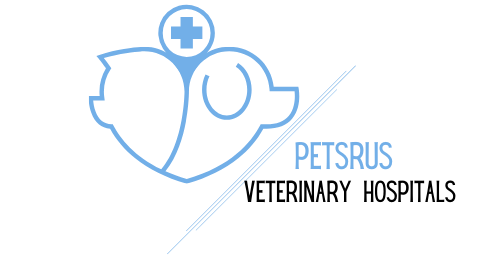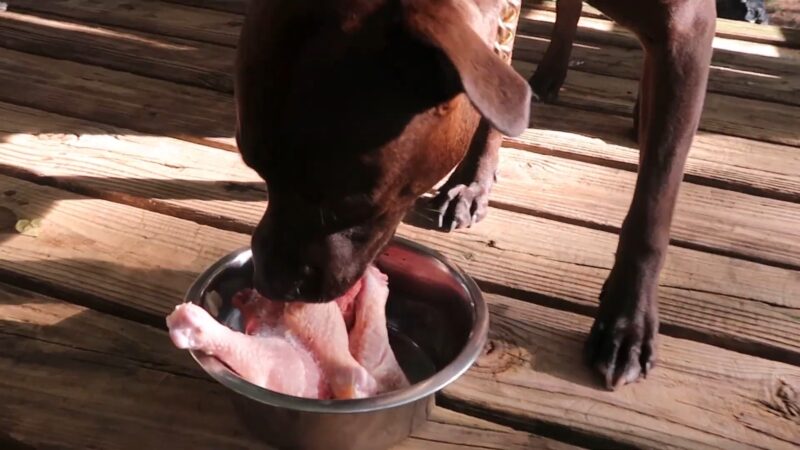We all agree that feeding our pets a balanced diet is crucial for their health and well-being. A balanced diet not only ensures that your dog gets the necessary nutrients for growth and development but also helps in maintaining a healthy weight, boosting the immune system, and supporting overall health.
One popular approach to achieving this balance is the raw food diet, which often includes raw chicken. But how much raw chicken should you feed your pet? The answer is not that simple, it depends on a variety of factors and today we’ll discuss them all.
The Raw Food Diet
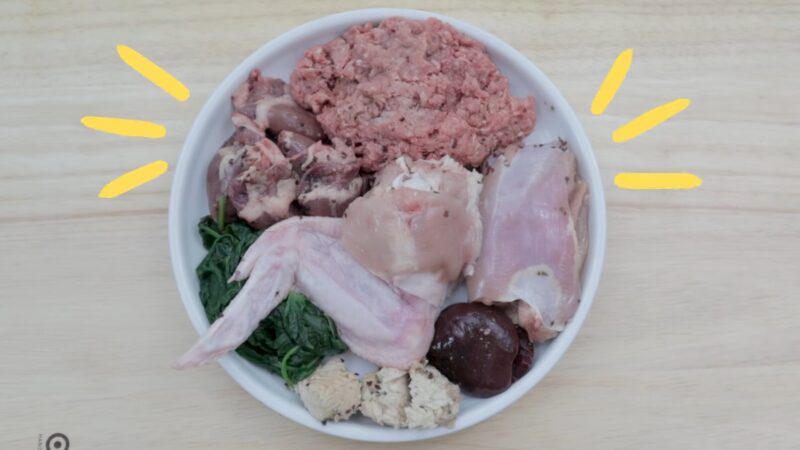
The raw food diet, also known as Biologically Appropriate Raw Food (BARF), is based on the principle of feeding dogs food that is closer to what their wild ancestors would have eaten. This diet primarily consists of raw meat, bones, fruits, and vegetables.
The idea is to mimic the diet of wolves, the closest wild relatives of domestic dogs. The belief is that this diet is more natural and healthier for dogs, leading to better digestion, healthier skin and coat, and increased energy.
The Controversy Surrounding These Diets
Despite its popularity, the raw food diet is not without controversy. Critics argue that raw diets can expose dogs to harmful bacteria and parasites that are usually killed during the cooking process.
They also point out that preparing a nutritionally balanced raw diet can be complex and time-consuming. It requires a deep understanding of canine nutrition to ensure that dogs are getting all the necessary nutrients in the right proportions. Critics also argue that there is a risk of physical harm from bones, such as choking, broken teeth, or internal punctures.
The Role of Chicken in a Raw Food Diet

Chicken is a popular choice for a raw food diet due to its affordability and availability. It’s also a good source of protein, which is essential for your dog’s health. Protein plays a crucial role in almost all biological processes, including cell repair, growth, and immune function.
It’s also necessary for the production of hormones and enzymes that your dog needs to function normally.
Nutritional Value of Raw Chicken
Nutritional Value Of Raw Chicken
Nutritional Value Of Raw Chicken (per 100g)
| Nutrient | Amount per 100g |
|---|---|
| Calories | 165 kcal |
| Protein | 31 g |
| Total Fat | 3.6 g |
| Saturated Fat | 1 g |
| Cholesterol | 85 mg |
| Sodium | 74 mg |
| Potassium | 256 mg |
| Total Carbohydrates | 0 g |
| Dietary Fiber | 0 g |
| Sugars | 0 g |
Raw chicken is rich in protein and contains essential nutrients like Vitamin B, Vitamin D, and various minerals. Vitamin B is essential for metabolic processes and maintaining the health of the nervous system, while Vitamin D is necessary for bone health and immune function.
Minerals such as zinc, iron, and selenium are also present in chickens and play vital roles in various bodily functions. These nutrients are vital for your dog’s health, contributing to muscle development, bone health, and overall well-being.
Determining How Much Raw Chicken to Feed Your Dog
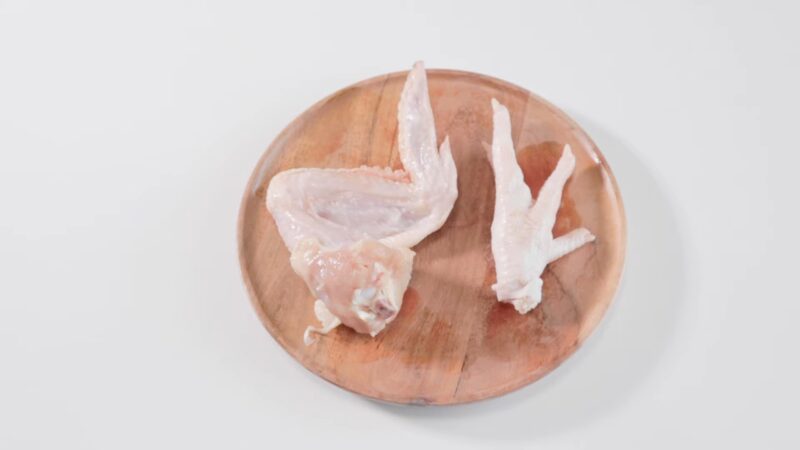
The amount of raw chicken you should feed your dog depends on various factors, including their weight, age, activity level, and overall health. It’s important to remember that every dog is unique, and what works for one may not work for another. Therefore, it’s crucial to monitor your dog’s health and adjust the diet as necessary.
Calculating Based on Weight
A common guideline is to feed dogs 2-3% of their body weight in raw food daily. For example, a 30-pound canine would need approximately 0.6 to 0.9 pounds of raw food per day. This amount should be adjusted based on the pet’s activity level and health status.
If your pet is overweight, you might need to feed less than the recommended percentage, and if your dog is underweight, you might need to feed more.
| Dog Weight (in pounds) | Daily Raw Food Amount (in pounds) |
|---|---|
| 10 | 0.2 – 0.3 |
| 20 | 0.4 – 0.6 |
| 30 | 0.6 – 0.9 |
| 40 | 0.8 – 1.2 |
| 50 | 1.0 – 1.5 |
| 60 | 1.2 – 1.8 |
| 70 | 1.4 – 2.1 |
| 80 | 1.6 – 2.4 |
| 90 | 1.8 – 2.7 |
| 100 | 2.0 – 3.0 |
Adjusting for Age and Activity Level
Puppies and highly active dogs may require more food, up to 5-10% of their body weight daily. This is because they have higher energy needs. Older, less active canines may need less. It’s important to monitor your pet’s weight and adjust portions to maintain a healthy weight. Regular vet check-ups can help you determine if your friend is at a healthy weight.
Balancing the Diet
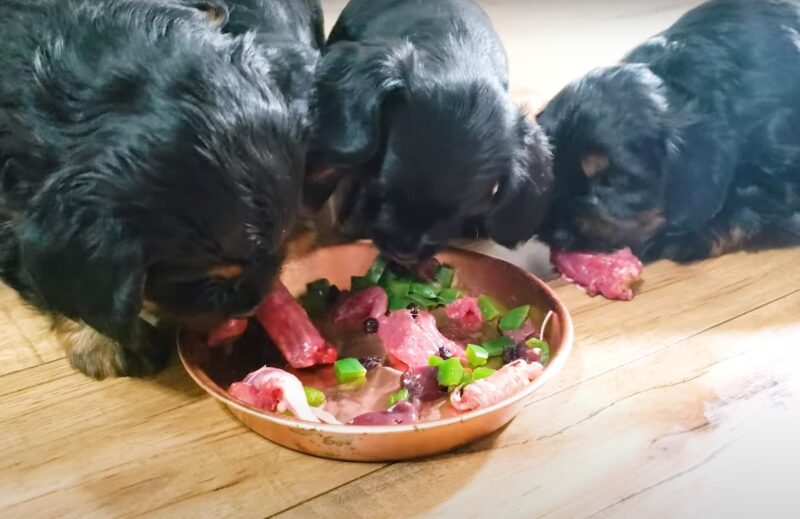
While chicken can be a significant part of your pet’s raw diet, it shouldn’t be the only component. A balanced diet should also include other meats, bones, organs, fruits, and vegetables. This ensures that your pet gets a variety of nutrients and reduces the risk of nutritional deficiencies.
Importance of Variety
Feeding a variety of foods ensures that your pet gets a range of nutrients. Different types of meats and organs provide different nutrient profiles. For instance, beef is a good source of iron, while the liver is rich in vitamin A.
Fruits and vegetables can also contribute essential vitamins, minerals, and fiber. They also provide antioxidants that can help protect your pet’s cells from damage.
Role of Bones and Organs
Bones are a good source of calcium and other minerals. They also provide mental stimulation and help keep your pet’s teeth clean. Organs, often referred to as “offal,” are nutrient-dense and should make up a significant portion of the diet.
However, they should be fed in moderation as they can be rich and potentially cause digestive upset if overfed. Organs like liver, kidney, and heart are rich in vitamins and minerals that are not found in muscle meat.
Transitioning Your Pet to a Raw Diet
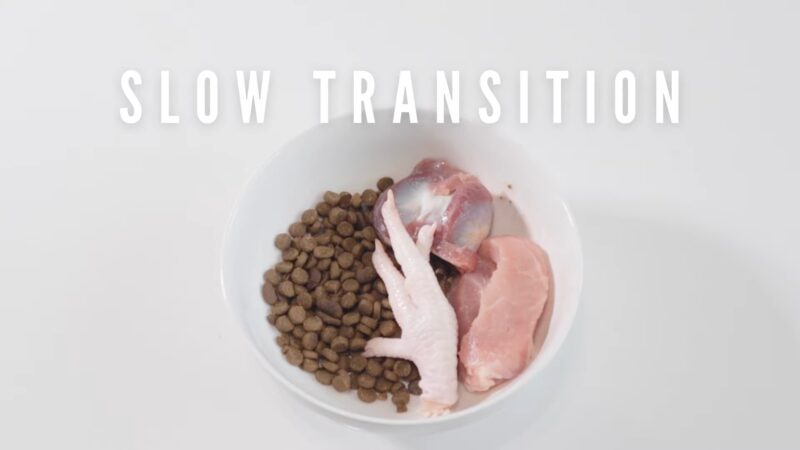
Switching your puppy to a raw diet should be done gradually to avoid digestive upset. Start by introducing small amounts of raw food into their regular diet and gradually increase the proportion over time. This allows your dog’s digestive system to adjust to the new diet.
Starting the Transition
Begin by replacing about 10% of your dog’s current diet with raw food. Monitor their digestion and stool quality. If they seem to be handling the change well, gradually increase the proportion of raw food. This process may take several weeks to months. It’s important to be patient and make the transition at a pace that your dog is comfortable with.
How to store the meat?
Proper handling and storage of raw chicken are crucial to minimize the risk of foodborne illness. Always wash your hands and any surfaces that come into contact with raw chicken. This not only protects your dog but also ensures the health and safety of your household.
Safe Handling Practices
Handle raw chicken as you would when preparing food for humans. This includes washing hands before and after handling, using separate cutting boards for raw meat, and cleaning all surfaces and utensils thoroughly. Never leave raw chicken out at room temperature, as this can lead to bacterial growth.
Potential Risks
This kind of diet comes with certain risks that pet owners should be aware of.
Bacterial Contamination
Raw chicken, like any raw meat, can be contaminated with harmful bacteria such as Salmonella and Campylobacter. These bacteria can cause foodborne illnesses in both dogs and humans who handle the food.
Foodborne Illness
If your dog consumes raw chicken contaminated with harmful bacteria, it can develop food poisoning or foodborne illnesses. Symptoms may include vomiting, diarrhea, lethargy, and loss of appetite, and in severe cases, it can lead to dehydration and other complications.
Nutritional Imbalance
Feeding an unbalanced raw diet may lead to nutritional deficiencies or imbalances, which can affect your dog’s overall health and well-being. A proper raw diet should be carefully planned and include a variety of foods to meet all of the dog’s nutritional needs.
Bones and Choking Hazard
Raw chicken bones can pose a choking hazard and may splinter when chewed, potentially causing internal injuries or blockages in the digestive tract.
Zoonotic Diseases
Dogs consuming raw chicken can become carriers of zoonotic diseases, which are diseases that can be transmitted from animals to humans. This increases the risk of infections for both the dog and the human family members.
Handling Hazards
Handling raw chicken also poses a risk to humans. The bacteria present in raw meat can be transferred to surfaces, utensils, and hands, leading to cross-contamination and potential illness.
Medical Conditions
Dogs with compromised immune systems, elderly dogs, puppies, pregnant dogs, and dogs with certain medical conditions may be more susceptible to the risks associated with raw chicken consumption.
It’s essential to discuss any dietary changes, including raw food diets, with your veterinarian to ensure that it is safe and appropriate for your individual dog’s needs. If you do choose to feed your pet raw chicken or a raw diet, take proper precautions to handle and store the food safely to minimize the risks to both your pet and your family.
Proper Storage
Raw chicken should be stored in the refrigerator and used within 1-2 days. If you need to store it longer, freeze it. Thaw frozen chicken in the refrigerator, not on the countertop. This reduces the risk of bacterial growth. Also, never refreeze chicken that has been thawed.
Consulting with a Professional
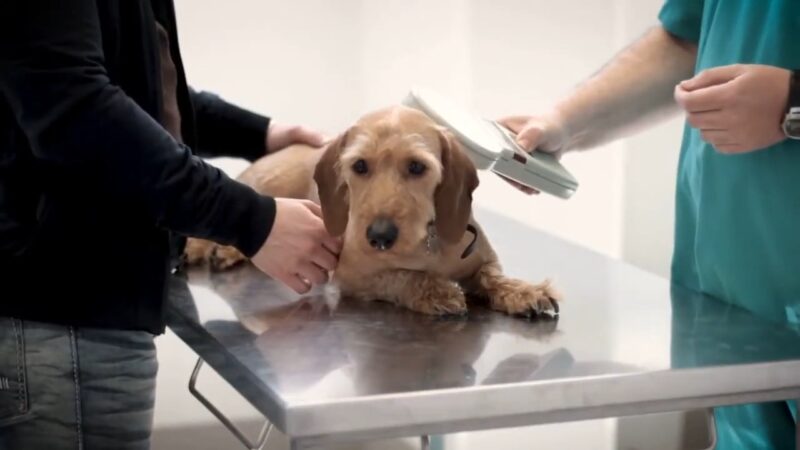
Before switching your dog to a raw diet, it’s recommended to consult with a veterinarian or a pet nutrition expert. They can provide guidance based on your pet’s specific needs and health status. They can also help you understand the risks and benefits of a raw diet and guide you in making the transition.
The Role of Your Veterinarian
Your veterinarian can provide valuable insights into whether a raw diet is suitable for your dog. They can also help monitor its health during the transition and make adjustments as necessary. Regular vet check-ups are important to monitor your pet’s weight, check for any nutritional deficiencies or excesses, and monitor overall health.
Finding a Pet Nutrition Expert
A pet nutrition expert can help you design a balanced raw diet for your friend. They can provide advice on portion sizes, variety, and supplements to ensure your dog is getting all the necessary nutrients. They can also provide guidance on safe handling and storage practices to minimize the risk of foodborne illnesses.
FAQs:
Can this meat help my dog gain weight?
This meat can be a good source of protein for your pet, which can help them gain weight. However, it’s important to balance it with other foods to avoid an unbalanced diet.
What should I do if my pet ate raw chicken?
If your dog ate raw chicken and is not used to it, monitor them for any signs of discomfort or illness. If they show symptoms like vomiting or diarrhea, consult a vet immediately.
Should I give it to my pet if they have a sensitive stomach?
If your dog has a sensitive stomach, it’s best to consult with a vet before introducing raw chicken to its diet.
Is it safe for puppies to eat it?
Puppies can eat this meat, but it’s crucial to introduce it slowly and in small amounts. Always consult with a vet before introducing raw food to a puppy’s diet.
Can I feed my dog raw chicken skin?
Raw chicken skin can be high in fat, which can lead to obesity and other health issues in dogs. It’s best to limit the amount of chicken skin in your pet’s diet.
Conclusion
Feeding your dog a raw diet, including raw chicken, can be a rewarding experience. It allows you to have control over what goes into your pet’s body and can lead to noticeable improvements in their health.
However, it’s crucial to do your research and consult with professionals to ensure you’re providing a balanced diet and minimizing potential risks. Remember, every dog is unique, and what works for one may not work for another.
Always prioritize your pet’s health and well-being and make dietary decisions based on their specific needs and circumstances.
